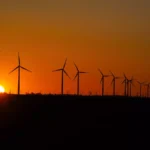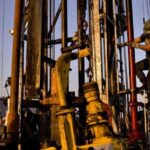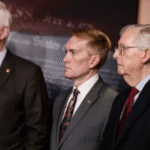Energy News Beat
Germany – The wind gusting across north German farm country brings much to the village of Sprakebuell: fog and rain from the sea, the occasional migrating stork, the faint smell of manure in the newly fertilized fields.
And perhaps best of all, money – from selling the electricity generated by the wind turbines studding the flat green fields stretching out to the North Sea. A slice of the cash goes to the villagers themselves, with the local buy-in making this windy farming enclave near the border with Denmark a showcase for ways to push ahead with renewable energy projects.
It’s not easy when headwinds from the post-pandemic global economy – including high interest rates and inflation – are holding back often costly investment in wind, solar and other forms of clean power.
That is slowing the growth in renewables needed to fend off climate change, just as it needs to speed up to meet an ambitious goal reached at the U.N. climate summit to boost clean energy capacity.
Milk prices fluctuate wildly, but the steadier income from the wind parks is “something we can rely on, something we can use to plan,” she said, occasional moos coming from the barn behind her.
The whoosh, whoosh, whoosh from the turbines – inaudible in the village center but noisy up close – contribute some 400,000 euros (over $432,000) a year in taxes. That paid for a new playground, a bike path and even free piano lessons for Sprakebuell’s children.
When it comes to new projects, global hurdles include higher borrowing costs that make it more costly to fund projects, high prices and clogged supply chains for wind turbines and blades, and “not in my backyard” resistance to wind farms.
Interest rate hikes from the U.S. Federal Reserve, the European Central Bank and others have economists at University College London warning of “green collateral damage” and calling high borrowing costs meant to fight inflation “terrible news for the green transition”
Consultancy Wood Mackenzie found that “clean energy has witnessed one of the toughest years in its short history” with government calls for more generating capacity going unfilled in Germany, Spain, the U.K. and Italy.
The situation is even more serious for lower-income countries in places like Africa, where borrowing costs for the higher up-front investment needed for renewables were already high and have risen even further.
In Sprakebuell, the number of family farms shrank from 26 in 1960 to three larger ones today, and it was on the verge of being merged with a neighboring village 30 years ago. These days, it’s home not just to farmers, but people who work a half-hour away in the city of Flensburg.
Sprakebuell’s residents put in the 20% down payment on building a wind park and local banks lent the remaining 80%. The first wind park had 24 participants; the latest one had more than 150 as word spread.
Nissen and her husband started with an investment of the equivalent of just over 5,000 euros ($5,560) more than 20 years ago. The dividends helped pay for a new calf stall, a front-end loader to shovel out animal feed and two workers.
“That means we sometimes have a free weekend, sometimes a vacation – and without employees, that’s impossible,” she said.
“Renewable energy projects are visible in the landscape, and for me, it’s very important that local people can identify with these projects,” said Christian Andresen, whose company, Solar-Energie Andresen GmbH, developed the wind farms and solar installations.
Andresen’s projects illustrate factors that can move renewables forward. One is the German government’s guaranteed price for electricity over 20 years, which gives banks confidence they can lend and get paid back.
Another is low interest rate loans from the government development bank, the KfW. But even those rates have risen, from 1% a few years ago to over 5%, Andresen said.
High interest rates hold back renewables far more than fossil fuel projects. Most of the cost for renewables is up-front in the price of buying the wind turbines or solar panels, while costs to operate them going forward are negligible – the wind blows and sun shines for free.
That makes the cost of borrowing a much more important factor in whether the project will be profitable.
It’s the other way around with fossil fuels: a natural gas-fired electricity plant is relatively cheaper to build, while the real costs come later in buying the gas.
On top of that is inflation, which has raised the cost of building facilities, and equipment shortages due to jammed supply chains.
Those were some reasons Danish company Orsted cited when it canceled two large wind installations off New Jersey. Swedish utility Vattenfall also halted an offshore project in the U.K.
In sub-Saharan Africa, where half the population lacks access to electricity, renewable projects face even steeper challenges with financing. With lots of sunshine, solar is an obvious option, but Africa’s 1.2 billion people have one-fifth the solar power of cloudy Germany.
Borrowing costs there are far higher than in rich countries, while government subsidies are uncertain because of political upheavals and countries already deep in debt.
In Nigeria, where blackouts are an everyday event for about half of the country’s 213 million people, some 14 solar projects have stalled because the finances don’t add up.
The government has been leery of World Bank credit guarantees that would make the projects bankable, concerned about being required to pay for the power even if the grid can’t deliver it.
And where locals are the owners instead of big energy companies, objections to wind towers’ appearance, shadows or whooshing tend to fade, said Andresen, the wind developer.
“When I have a share in it, it’s a nice noise and a nice view,” he said.
The post Wind and sun are free, but it’s harder to get renewable energy projects built these days. Here’s why first appeared on Energy News Beat.
The post Wind and sun are free, but it’s harder to get renewable energy projects built these days. Here’s why appeared first on Energy News Beat.








